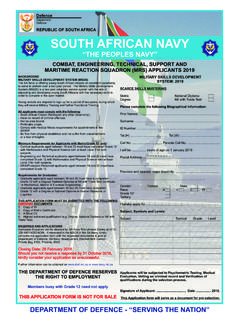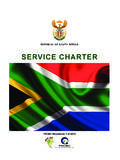Transcription of FACTORS INVOLVED IN COMBAT READINESS IN …
1 FACTORS INVOLVED IN COMBAT READINESS IN africa Ntokozo Shinga Gideon van Dyk Faculty of Military Science Stellenbosch University south africa Email: 1. INTRODUCTION Over the past few decades africa has emerged as the major arena for United Nations (UN) peace operations (De Coning, 2007). south africa as a contributing country to UN peace operations efforts mainly in the African continent, plays a vital role in the complex African peace operations. 5/28/2015 2 Ahere (2009) describes peacekeeping as the deployment of people (soldiers, military observers or civilian police) aimed at assisting the parties to a conflict to find ways to resolve their differences peacefully. Allais (2011, p. 2) describes UN peacekeeping as a unique and dynamic instrument developed by the organisation as a way to help countries torn by conflict create conditions for lasting peace 5/28/2015 3 Peacekeeping environments are much less controllable nor predictable than conventional warfare environments (Bester & Stanz, 2007).
2 An operation may change over a short period of time (from Chapter VI to Chapter VII). The role and purpose of the soldiers may be similarly unclear. Lotze, De Coning and Neethling (2013) argue that south africa s contribution to international peace operations are characterised by a number of trends. 5/28/2015 4 The contributions are firstly strongly informed by the country s political engagements on the African continent. Secondly, south africa s contributions to peace operations are linked to the country s growing self-image as an emerging middle power , and as an African power, in the international arena. 5/28/2015 5 Nowadays peace operations are multidimensional in nature, characterised by violence and brutality where peacekeepers are often confronted with atrocities seldom heard of, or seen before (Ross, 2008).
3 Although in comparison with traditional wars characterised by high rates of death and calamity, peacekeeping operation expose soldiers to multiple challenges both physical and psychological such as unexpected emotions of fear, hectic states, depression, anger, and apathy (Van Dyk, 2009). 5/28/2015 6 A number of reported incidents in deployment areas where the south African National Defence Force (SANDF) participates serve as evidence of the multidimensionality of peacekeeping operations. The incident in March 2013 in the Central African Republic (CAR), where south African soldiers were faced with a situation where death became a reality and the level of COMBAT - READINESS was put to the test, served as reality check for the SANDF. 5/28/2015 7 Stupart (2013, p. 1) quotes the Chief of the SANDF General Shoke who stated, 200 paratroopers and Special Forces troops faced off against 3 000 rebels advancing on a one kilometre wide front was no laughing matter.
4 This resulted in the death of 13 of SA soldiers 5/28/2015 8 This resulted in the death of 13 of SA soldiers The south African Government News Agency (2014) reports that during an ambush in Kutum, in the northern Darfur region of Sudan, two SANDF soldiers were injured. 5/28/2015 9 The Defence Website (2013, p. 1) report that on October 17, 2012, a south African soldier was killed and two injured during an ambush on a convoy in Darfur in the Democratic Republic of Congo (DRC) This has necessitated that the SANDF put more emphasis to COMBAT READINESS for its forces 5/28/2015 10 2. COMBAT READINESS 1986 Gal described COMBAT READINESS as a psychological attribute in terms of a soldier s choice or degree of commitment to, and persistence in effecting a certain course of action (Bester & Stanz, 2007) the author views the concept of COMBAT READINESS as the soldier s level of preparedness as being prepared psychologically and physically through training and psychological interventions aimed at developing a soldier s capability to perform a given military task successfully 5/28/2015 11 Soldier s COMBAT READINESS Deployment READINESS Quick Reference Guide ( , p.)
5 105 106) state that, soldier-well-trained and well-equipped-fierce, disciplined, mentally and physically tough, intelligent, flexible, and compassionate ultimately represents forces effectiveness and future capabilities High-quality, motivated and well-trained soldiers in necessary numbers and ranks are essential to CR (Dunn, 2013) CR levels are supported by components such as personnel READINESS , material READINESS , unit READINESS (Both, 1984), and soldier s state of mind 5/28/2015 12 The psychological aspect of a soldier s well-being (developing a hardy soldier) lies with the utilisation of the MPT; hence, a close partnership between military leaders and the MPT would benefit both the soldier and the military organisation to a large extent. Griffith (2002) posits that positive leader behaviour, such as consideration, respect, and recognition, serve as an enhancement to a soldier s pride, well-being and identification with the leader, unit and the military organisation 5/28/2015 13 Material READINESS According to the Department of the Army (2009, p.
6 9), functional, reliable and maintained equipment is essential for the success of an operation Soldier s perception of being CR includes having confidence not only in his/her own abilities but also confidence in the resources provided to effect the success of the operation There are two FACTORS INVOLVED in equipment READINESS , these include the number and type of equipment used and the operational status of the equipment (Dunn, 2013) 5/28/2015 14 Unit READINESS Unit READINESS refers to the ability of a unit to deliver the output for which it was designed (Meinhart, 2001, p. 116). Unit READINESS can be affected by many FACTORS which may be analysed both subjectively and objectively (Blankmeyer, 1998). FACTORS of interest for this research included training, unit cohesion and unit performance in preparation for peace operations Training Cohesion 5/28/2015 15 COMBAT READINESS as a state of mind Bester and Stanz (2007) posit that when preparing for an operation, the military force owes as much to the soldiers state of mind as it does to his training and operational equipment.
7 The complexity of operations requires soldiers who are both physically and psychologically prepared to withstand the calamity presented by the operation and possible non-military challenges (such as the separation from loved ones). 5/28/2015 16 The soldier s apprehension and reaction to such unpredictable environments are affected by the level of preparedness, the soldier s state of mind and the level of hardiness at that moment Research shows that support from the soldier s spouse and military unit, particularly leadership, has a great influence on the soldier s CR and ability to perform successfully in operations (Kirkland & Katz, 1989; Rotter & Boveja, 1999) 5/28/2015 17 Although a harmonious relationship between the soldier s family and the unit is ideal and most vital in maintaining the soldier s state of mind in order to achieve CR, it is recognised that both the unit and the spouse demand the soldier s emotional commitment and energy Conflict between the needs of the unit and the needs of the spouse may inhibit soldier s mental agility essential for CR In order to bridge and harmonize the two important entities, the utilisation of the MPT is essential 5/28/2015 18 The soldier s state of mind as a psychological component to CR may be broad.
8 Some of the dimensions influencing the soldier s state of mind may include and are not limited to, intra psychic, ego power, self-confidence, self-efficacy, hardiness, dareness and other components of personality (Parrew & Ganster, 2011). These psychological components have an impact in the soldier s willingness to fight, a will power of commitment in which a soldier is prepared to die for his/her unit and country 5/28/2015 19 5/28/2015 Figure 1 COMBAT READINESS : A State of Mind for a Soldier 3. FACTORS INVOLVED IN COMBAT READINESS Research shows that support from the soldier s spouse and military unit, particularly leadership, has a great influence on the soldier s CR and ability to perform successfully in operations (Kirkland & Katz, 1989; Rotter & Boveja, 1999) 5/28/2015 21 Soldier s relationship with spouse In the military context, spouse refers to what (Kgosana, 2010, p.)
9 14) describes as a subsystem to a family unit to which a soldier belongs, formed when two adults of the opposite sex join with the express purpose of forming a family and, although the agreement does not have to be legal to be significant, members must however be able to fulfil certain roles (Minuchin & Fishman, 1981) The author describe a spouse to be, a person, a significant other with which the soldier has a relationship or some kind of arrangement, irrespective of the inclusion of children and marriage; rather, the bond between the two parties. 5/28/2015 22 As a family, the soldier and spouse, function in a systemic way in which both parties share an emotional bond, providing mutual satisfaction for each other s needs without compromising the emotional environment necessary for growth (Dallos & Draper, 2000) This supposition especially applies to African families where interactions between members of the family is grounded on carefully established boundaries and roles that have been passed down from generation to generation.
10 5/28/2015 23 Salvador Minuchin and Braulio Montalvo are the founders of this structural approach, which has proved significant in family therapy Kirkland and Katz (1989) revealed a positive synergy between the unit and the family experienced by the soldier in each. This synergy as experienced by the soldier strengthens his/her ability to function successfully in both institutions. 5/28/2015 24 The soldier s improved functioning raises the performance level of the unit and the stability of the family. When there is a well-integrated unit and stable family integration within which the soldier functions optimum enhancement will occur. Well-prepared, informed and stable families have in the past proved to be instrumental in the creation of a COMBAT -ready soldier. The spouse remaining home can be proud and confident in his/her ability to handle family affairs during the soldier s deployment.








